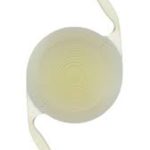What are Intraocular Lenses?
Our patients often desire freedom from glasses and contact lenses for all of their activities. Newly developed technologies over the years have moved us all closer to that goal. Advances in laser cataract surgery with implantable intraocular lenses (IOLs) have greatly improved the quality of life of our patients.
Up until now, patients who had cataract surgery only had one choice when it came to intraocular lens options — a fixed focus intraocular lens. These lenses allow for either great distance vision without glasses but the need for reading glasses for near or computer work, or vice versa. Also, these fixed-focus lenses do not correct astigmatism. Therefore, even though removing the cataract may clear their vision, patients with astigmatism still need corrective eyewear or contact lenses after surgery to reduce the blurring and distortion caused by their astigmatism.
ECI now has more intraocular lens options available to our patients. New technology “lifestyle lens implants” include multifocal lenses, astigmatism-correcting lenses, and accommodative lenses. Many of our patients achieve freedom from glasses or contacts for most or all of their visual needs with these new lenses. They allow for better quality vision at distance as well as for near vision tasks such as for computer work, cell phone, menus, or reading materials. To learn more about how an intraocular lens works, view the video below. To find out more about the lifestyle lens implant options available to you, see any of the IOL images below.




What are the benefits of these premium IOLs?
We’ve discussed mono-focal IOLs, which were formerly the only option for replacing the natural lens that has developed the cataract. Patients had to decide the distance they wanted to see clearly. Usually, this was a distance vision. The patient then needed glasses for medium and up-close vision.
Today’s premium IOLs now offer vision correction at different distances with both accommodating and multifocal IOLs. This means they correct for near- and farsightedness. They also correct for astigmatism with toric IOLs. The most recent technological upgrade was the addition of a toric function to multifocal and accommodating IOLs. Premium IOLs also correct for presbyopia, the condition that is almost universal after the age of 40 where the eye has more difficulty focusing for near vision.
Some of our patients wonder if getting these new lenses is worth the cost difference since they are not covered by basic Medicare (you pay the difference between mono-focal IOLs and premium IOLs). We ask them how much they like searching around the house for their reading glasses every time they pick up a magazine or want to work a crossword puzzle. These lenses allow you to see at all distances, and most of our patients love that.
Who is a good candidate for multifocal or accommodating IOLs?
As technology continues to evolve, patients have more and more options for their cataract replacement intraocular lens. Compared to the once-standard monofocal IOLs that only gave the patient clear vision at a single distance (distance or up-close vision), today you can opt to choose a new intraocular lens that provides clear vision at all distances. Many patients can now completely or near completely remove the need for reading glasses for up-close vision. The newest multifocal lenses and accommodating IOLs can even correct for astigmatism and for presbyopia.
Multifocal IOLs are not covered by the basic Medicare options; they cover mono-focal lenses. Most people feel the upgrade is well worth the added cost. Some have better vision with these lenses than they ever enjoyed in their life before they developed cataracts. This is because these new multifocal and accommodating lenses give them perfect or near-perfect vision at all distances, and most people formerly had some degree of refractive errors (nearsightedness, farsightedness, or astigmatism) in their younger days.
At Eye Care Institute, we walk you through your options and help you understand the pros and cons of each premium intraocular lens option. Just about everyone having cataract surgery is a great candidate for these new IOLs.
Really the only people who would not be right for multifocal or accommodating IOLs would be those who need precise, perfect vision at distance. Think of pilots or other occupations that require perfect distance vision.
What are the different types of intraocular lens available today?
Here’s a breakdown of the premium intraocular lens choices:
Multifocal IOLs
Multifocal IOLs have focal zones, or rings, that allow you to see clearly at both near and far distances. While this intraocular lens may not completely remove your need for glasses at all times (such as extended periods reading), they will dramatically reduce the need. Some studies have shown that multifocal IOLs provide better near vision than accommodating IOLs, but they are also more likely to cause glare or mildly blurred distance vision as a tradeoff.

Accommodating IOLs
Like multifocal IOLs, accommodating IOLs expand the range of focus to both near and far, but they do this is a different fashion. Accommodating IOLs have what are called “haptics” on the ends. These supporting legs hold the intraocular lens in place inside the eye. This haptics is flexible and they allow the accommodating IOL to move forward slightly when you look at near objects, which increases the focusing power of the eye enough to provide good near vision.
Toric IOLs
Toric IOLs help those with astigmatism. These are the most recent addition to premium IOLs. They correct for astigmatism as well as nearsightedness or farsightedness. They do this through different powers in different meridians of the lens. These intraocular lenses have alignment markings on the peripheral part of the lens that enables the surgeon to adjust the orientation of the IOL inside the eye for optimal astigmatism correction.
The development of toric IOLs has basically removed the need for what is called limbal relaxing incisions. These were formerly the way astigmatism could be reduced during cataract surgery. These small incisions were made at opposite ends of the cornea. When they healed, the cornea would become more spherical in shape compared to the more oval shape of a cornea with astigmatism.

Which premium IOL is best for me?
At Eye Care Institute, we love educating our patients about the different options they now have with cataract surgery. There are differences between multifocal and accommodating IOLs that can help make the choice one way or the other.
But you really can’t go wrong with either choice. And now you can add astigmatism correction to both multifocal and accommodating IOLs.
How are premium IOLs placed?

These lenses are placed in the same method as monofocal IOLs, with a difference for toric IOLs. After your Eye Care Institute surgeon makes a tiny incision in the cornea of your eye, a small needle-thin probe is inserted into the lens where the cataract has formed. The probe transmits ultrasound energy to break up, or emulsify, the cataract. The probe then suctions out the fragments.
The lens capsule at the very back of your lens is left intact to serve as the place for the artificial intraocular lens to rest. The intraocular lens you have selected is then inserted to replace the removed cataract-clouded natural lens. Usually, stitches are not even necessary to close the tiny incision in the cornea, which heals in just a couple of days.
This procedure is the same for monofocal, multifocal, or accommodating IOLs, with one difference. With toric IOLs (either type), there are alignment markings on the peripheral part of the lens that is used by your surgeon to adjust the orientation of the intraocular lens inside the eye. This provides optimal astigmatism correction.
What is recovery like after having cataract surgery?
For the first few days after your cataract surgery at our Santa Rosa offices, your vision may be blurry as your eye heals and adjusts to your new premium IOL. Colors will seem brighter now, as your lens is crystal clear. Cataracts tend to mute colors because the protein buildup is blocking some of the light.
We see you for a follow up appointment in a day or two after your surgery, and then again in about one month. Your eye will have some mild itching and discomfort for a couple of days, but you need to avoid itching or pushing on your eye at all. You’ll wear an eye shield we provide for sleep. In a few days, you’ll feel good and your vision will be dramatically improved. Full healing can take up to eight weeks, but you’ll have full improved vision long before that.
Will I need to ever replace my premium IOLs?
These are permanent surgeries. Your clouded cataract lens is removed, and it is replaced by an artificial IOL. These lenses will not cloud or degrade in any way. They are meant to stay in your eye for the rest of your life.
Are there risks with cataract surgery and placement of intraocular lens? Are they safe?
Cataract surgery is so common that eventually over half of the population will likely have it. Complications are very rare, and if any of these happen, they can usually be successfully treated. The following risks are no different with premium or monofocal IOLs:
- Inflammation
- Infection
- Bleeding
- Swelling
- Drooping eyelid
- Dislocation of the IOL
- Retinal detachment
- Glaucoma
- Loss of vision

What People Say About Us!
"The whole process is so well done. You couldn't go to a better place to have cataracts taken care of. The pre evaluation is done by a great team, everyone really takes special care of the cataract prospects. I definitely will have the Eye Care Institute take care of my optical care."
Click here to read more reviews.
Schedule a Consultation Today!
If you're interested in learning more about Intraocular Lens please contact us for a consultation at 707.546.9800 or fill out our contact us form. We will discuss your needs and concerns, and determine your best course of action.